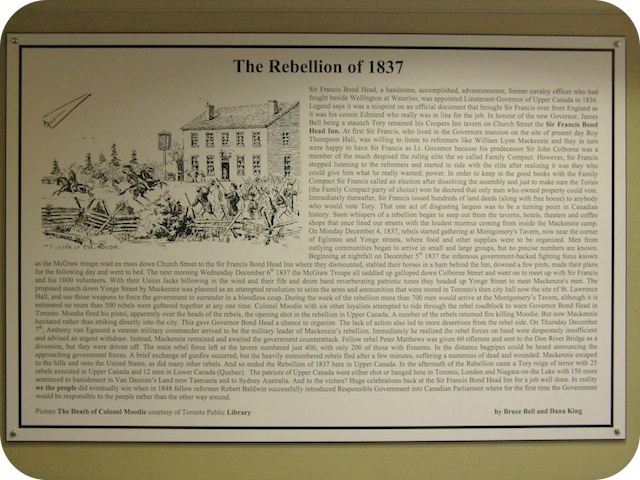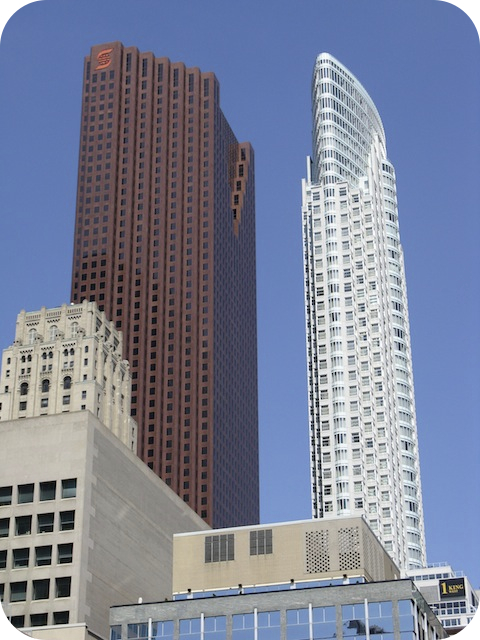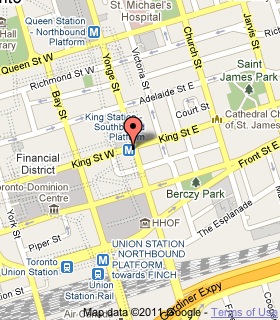Discover Toronto's history as told through its plaques
2004 - Now in our 14th Year - 2018
To see what's new on this site, you can visit the Home Page
Looking at this page on a smartphone?
For best viewing, hold your phone in Landscape mode (Horizontal)
The Rebellion of 1837

Photos and transcription by contributor Wayne Adam - Posted April, 2010

At 1 King Street West (the white tower on the right) at the elevator lobby on the 31st floor, is this Bruce Bell and Dana King plaque. Here's what it says:
Coordinates: 43.648780 -79.378254 |
 |
Sir Francis Bond Head, a handsome, accomplished, adventuresome, former cavalry officer who had fought beside Wellington at Waterloo, was appointed Lieutenant-Governor of Upper Canada in 1836. Legend says it was a misprint on an official document that brought Sir Francis over from England, as it was his cousin, Edmund, who really was in line for the job. In honour of the new Governor, James Bell, being a staunch Tory, renamed his Coopers Inn tavern on Church Street the Sir Francis Bond Head Inn. At first, Sir Francis, who lived in the Governor's mansion on the site of present-day Roy Thompson Hall, was willing to listen to reformers like William Lyon Mackenzie and they, in turn, were happy to have Sir Francis as Lt. Governor, because his predecessor, Sir John Colborne, was a member of the much-despised ruling elite, the so-called Family Compact. However, Sir Francis stopped listening to the reformers and started to side with the elite after realizing it was they who could give him what he really wanted: power. In order to keep in the good books with the Family Compact, Sir Francis called an election after dissolving the assembly and, just to make sure the Tories (the Family Compact party of choice) won, he decreed that only men who owned property could vote. Immediately thereafter, Sir Francis issued hundreds of land deeds (along with free booze) to anybody who would vote Tory. That one act of disgusting largess was to be a turning point in Canadian history. Soon whispers of a rebellion began to seep out from the taverns, hotels, theatres and coffee shops that once lined our streets, with the loudest murmur coming from inside the Mackenzie camp.
On Monday, December 4, 1837, rebels started gathering at Montgomery's Tavern, now near the corner of Eglinton and Yonge Streets, where food and other supplies were to be organized. Men from outlying communities began to arrive in small and large groups, but no precise numbers are known. Beginning at nightfall on December 5th, 1837, the infamous government-backed fighting force known as the McGraw Troupe rode en mass down Church Street to the Sir Francis Bond Head Inn, where they dismounted, stabled their horses in a barn behind the Inn, downed a few pints, made their plans for the following day, and went to bed. The next morning, Wednesday, December 6th, 1837, the McGraw Troupe, all saddled up, galloped down Colborne Street and went on to meet up with Sir Francis and his 1000 volunteers. With the Union Jacks billowing in the wind and their fife and drum band reverberating patriotic tunes, they headed up Yonge Street to meet Mackenzie's men.
The proposed march down Yonge Street by Mackenzie was planned as an attempted revolution to seize the arms and ammunition that were stored in Toronto's then city hall, now the site of St. Lawrence Hall, and use those weapons to force the government to surrender in a bloodless coup. During the week of the rebellion more than 700 men would arrive at Montgomery's Tavern, although it is estimated no more than 500 rebels were gathered together at any one time. Colonel Moodie, with six other loyalists, attempted to ride through the rebel roadblock to warn Governor Bond Head in Toronto. Moodie fired his pistol, apparently over the heads of the rebels, the opening shot in the rebellion in Upper Canada. A number of the rebels returned fire, killing Moodie.
But now Mackenzie hesitated rather than striking directly into the city. This gave Governor Bond Head a chance to organize. The lack of action also led to more desertions from the rebel side. On Thursday, December 7th, Anthony van Egmond, a veteran military commander, arrived to be the military leader of Mackenzie's rebellion. Immediately, he realized the rebel forces on hand were desperately insufficient and advised an urgent withdrawal. Instead, Mackenzie remained and awaited the government counterattack. Fellow rebel Peter Matthews was given 60 riflemen and sent to the Don River Bridge as a diversion, but they were driven off. The main rebel force left at the tavern numbered just 400, with only 200 of those with firearms. In the distance, bagpipes could be heard announcing the approaching government forces. A brief exchange of gunfire occurred, but the heavily outnumbered rebels fled after a few minutes, suffering numerous dead and wounded. Mackenzie escaped to the hills and on to the United States, as did many other rebels.
And so ended the Rebellion of 1837 here in Upper Canada. In the aftermath of the Rebellion came a Tory reign of terror with 25 rebels executed in Upper Canada and 12 men in Lower Canada (Quebec). The patriots of Upper Canada were either shot or hanged here in Toronto, London and Niagara-on-the-Lake with 150 more sentences to banishment in Van Damien's Land, now Tasmania, and to Sydney, Australia. And to the victors? Huge celebrations back at the Sir Francis Bond Head Inn for a job well done. In reality we the people did eventually win when, in 1848, fellow reformer Robert Baldwin successfully introduced Responsible Government into Canadian Parliament where, for the first time, the Government would be responsible to the people rather than the other way around.
Related webpages
Sir Francis Bond Head
Duke of Wellington
Battle of Waterloo
Roy Thompson Hall
Sir John Colborne
Family Compact
St. Lawrence Hall
Robert Moodie
Anthony van Egmond
responsible government
Related Toronto plaques
Montgomery's Tavern
Samuel Lount and Peter Matthews
William Lyon Mackenzie 1795-1861
The Types Riot
The Colborne Street Theatre
Robert Baldwin 1804-1858
The Bishop's Palace 1818
David Gibson 1804-1864
Robert Gourlay 1778-1863
More Bruce Bell History Project plaques
132 Front Street East
The Colborne Street Theatre
First Theatrical Performance
The Great Fire of 1849
Keating Coffee House
Robert Baldwin 1804-1858
Samuel Lount and Peter Matthews
The War of 1812 & the Siege of York
West Market Street
York's First Jail
Related Ontario plaque
Anthony van Egmond
1837 Rebellion
More
Conflict
Here are the visitors' comments for this page.
> Posted March 28, 2015
In Thornhill, Ontario, a plaque relates how the Rebellion of 1837 divided even leading citizens, and how bonds of friendship trumped even one's convictions. It was erected in 1981 by the Society for the Preservation of Historic Thornhill, and is located on John Street at Confederation Way (43.814825, -79.422320). Here's what the plaque says:
"Richard Sutton Frizzell 1817 - 1876
Richard Frizzell, a Tory Loyalist active during the Rebellion of 1837, was disdainful of the rebel's cause. On October 18, 1837 he removed a 'Liberty or Death' flag from Gibson House and wove it into the tails of the rebels' horses outside. On December 4, noticing rebel movement on Yonge Street, Frizzell approached Benjamin Thorne, Thornhill's founder, for assistance. Thorne was reluctant to lend a horse as his Mill workers were mostly rebels, but he offered encouragement. After warning Sir Francis Bond Head at York (Toronto), Frizzell took part in the ensuing skirmishes but he refused to betray the location of his rebel friend Samuel Lount who was captured and hanged for treason." -Wayne
Here's where you can send me a comment for this page.
Note: Your email address will be posted at the end of your comment so others can respond to you unless you request otherwise.
Note: Comments are moderated. Yours will appear on this page within 24 hours (usually much sooner).
Note: As soon as I have posted your comment, a reply to your email will be sent informing you.
To send me your comment, click [email protected].
Thanks
Webmaster
Note: If you wish to send me a personal email, click here.